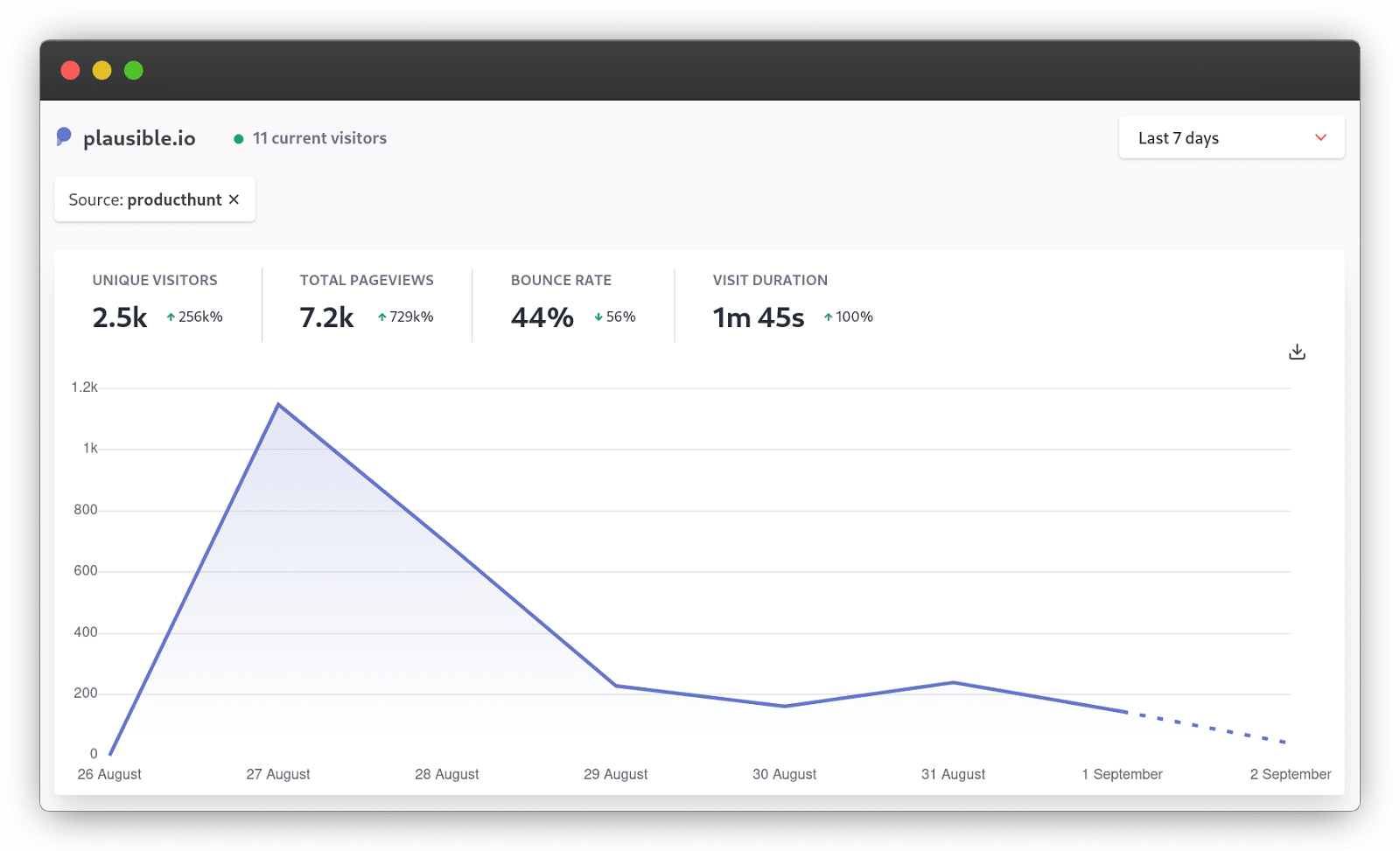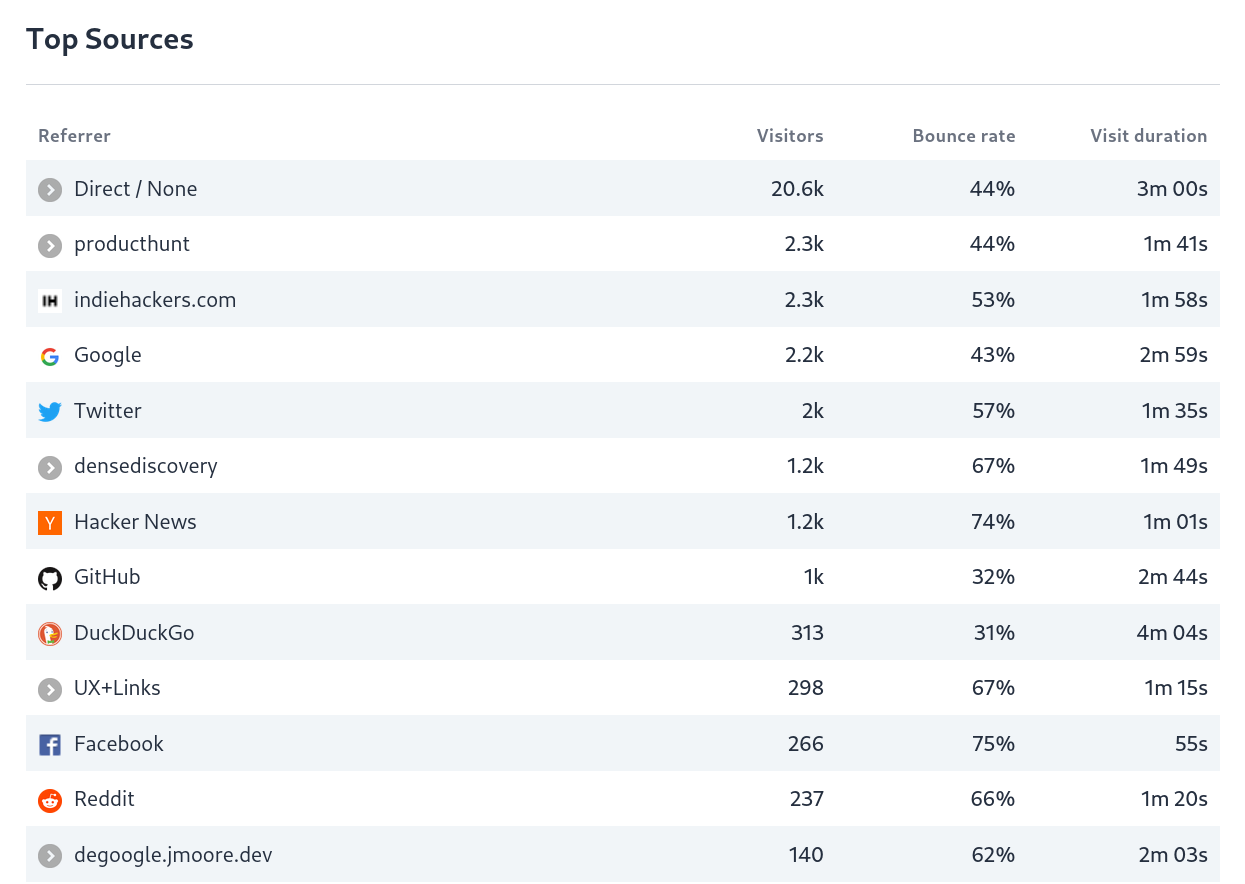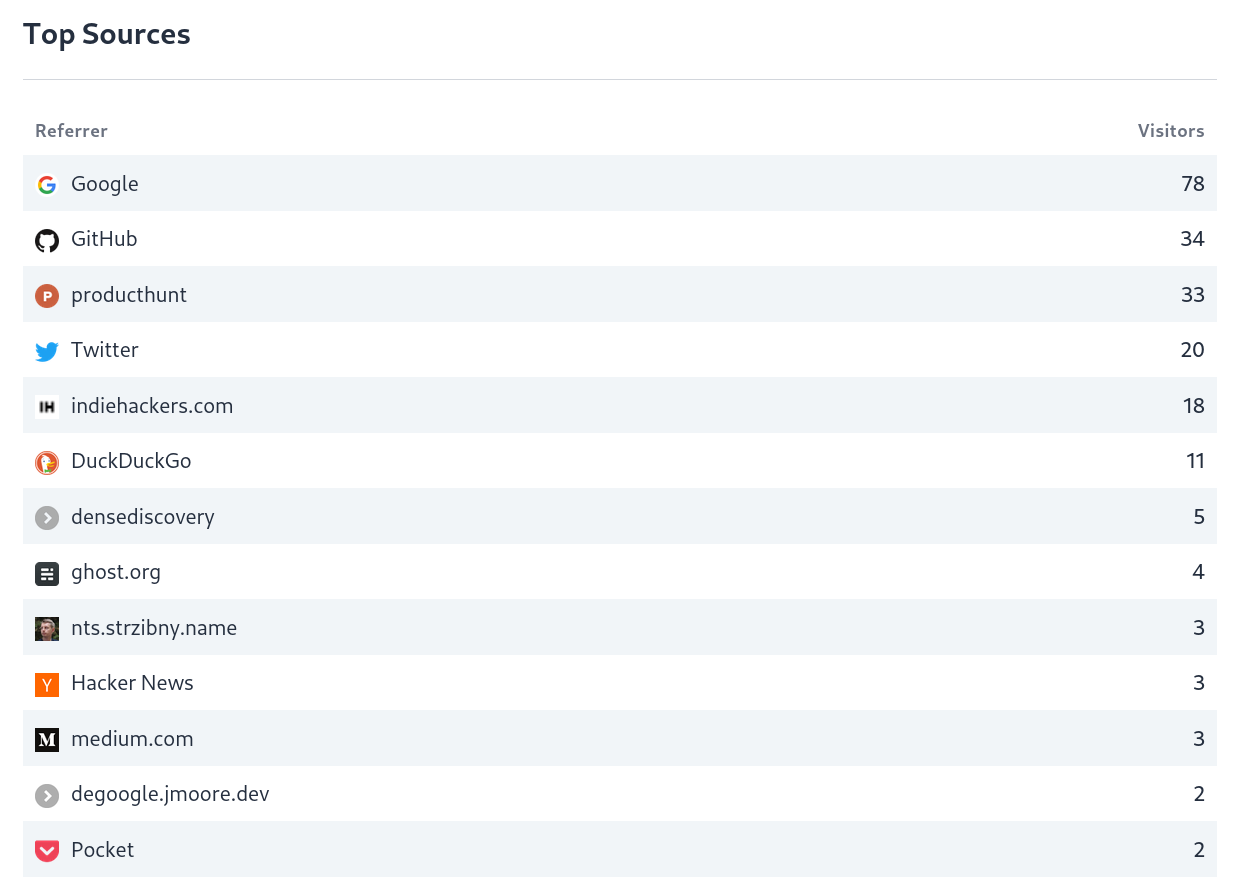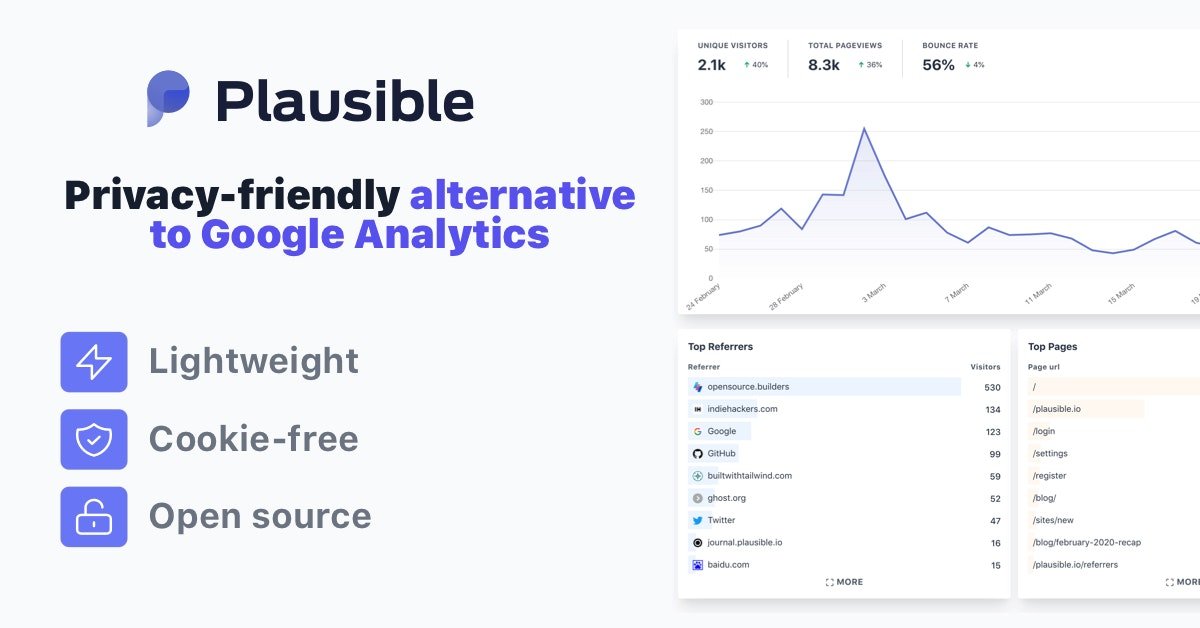How not to launch on Product Hunt (and lessons from our successful launch)

We’ve just had a successful Product Hunt launch for Plausible Analytics. More than 850 upvotes, more than 100 comments, featured twice on the official Twitter account and in the daily and weekly newsletters too.
And no. You don’t need to join any Slack or Facebook groups to upvote each other’s products. You don’t need a famous hunter. You don’t need to create a spreadsheet with contact details of people you’ll ask for upvotes. You don’t need to bother people by creating hype days in advance. You don’t need to gather an army of soldiers or an army of fake users either.
Let’s get started with our experience and what we learned launching on Product Hunt.
- Don’t overcomplicate and overthink your Product Hunt launch
- Plausible Analytics launch on Product Hunt
- Our Product Hunt referral traffic and trial conversions
- The spike of hope, the flatline of nope and why Product Hunt is not the holy grail of your startup marketing
- Two possible approaches for your Product Hunt launch
- Product Hunt launch checklist
- What time to launch
- Include one nice featured image
- Self-hunting vs an established hunter
- Don’t ask for upvotes, buy upvotes or try to game the system
- How to start the promotion to get the upvotes rolling
- Don’t ignore Product Hunt after your launch campaign is completed
- Read the official launch guide
Don’t overcomplicate and overthink your Product Hunt launch
Too many startup founders spend way too much time being concerned and thinking about launching on Product Hunt.
I’ve heard founders say things such as “I’m just dreaming about when I launch on PH and after that I’m a millionaire” or “I’m trying to pluck up the courage to launch on PH” or asking “how do you know when’s the right time” and “what’s the final push to launch”.
Product Hunt is a popular platform with a supportive community and it’s a great place to get some attention for your startup and be discovered. But it’s only one of the many other great niche communities where you can do the same.
Don’t dream too much about launching on Product Hunt and getting hundreds of paying customers on the day so you can immediately quit your job. If you have such high expectations, you’re bound to be disappointed. This dream may come true to a few products but it’s an unrealistic expectation for most.
And certainly don’t go to search engines looking for launch advice or guides. When I started writing this post I had a quick look at what posts ranks on the first page of search and I didn’t like what I saw.
So much spam and so much bad and generic advice that simply cannot work. Or at least it makes your chances of succeeding much lower and gets you to focus on and waste time on useless things. No wonder many founders end up being hesitant about their launch.
Plausible Analytics launch on Product Hunt
We launched on Product Hunt on August 27th with a year and a half delay or so from the actual launch of the product. Here’s our page on Product Hunt.

What was the final push that made us decide that we’re launching on Product Hunt? No specific reason. As a marketer, I’m always looking for new platforms and places where to reach more relevant and interested people. Product Hunt was a platform we didn’t explore yet and it was about time.
On August 11th I tweeted asking what’s the best launch approach getting some useful replies. Then I went on a holiday, returned on August 24th and on August 26th on our daily call we briefly mentioned Product Hunt and agreed to go for it the day after.
There was no specific reason other than trying to see what Product Hunt could do for us. No month-long preparation and no high expectations either that Product Hunt would make us an overnight success.
Our Product Hunt referral traffic and trial conversions
We ended up having a relatively successful Product Hunt launch.
After the first 24 hours, we had 601 upvotes (finished #2 on the day), 90 comments (includes our replies too and we tried to reply to everyone) and 26 reviews with a score of 4.8/5. It was great to read all the amazing comments and we are grateful to all the people who took their time to upvote and leave feedback.
Product Hunt shared our listing twice from their official Twitter account. As we got #2 on the day, we were featured in their daily newsletter too. We also got featured in their weekly newsletter as we finished in the top 10 of the week (#7).
Within the first 24 hours, we got 1,490 unique visitors from Product Hunt to our website. We also got 22 trial signups from there.
And now, almost a week after the launch, we’re on more than 850 upvotes, more than 100 comments and 27 reviews with a score of 4.8/5. 2,560 unique visitors to our website, with a bounce rate of 44%, average visit duration of 1 minute and 44 seconds and 36 trial signups.
You can take a look at the full real-time details of the traffic we got from Product Hunt on our live demo. Product Hunt ended up being our top referral source of traffic in August even though we launched at the very end of the month.

On top of this, I believe we will see other benefits of being on Product Hunt. It’s always difficult to measure brand awareness and the impact our Product Hunt listing will have in the coming weeks and months, but I’m hoping we will continue seeing a trickle of visitors day after day.
Comparison of our referral sources and their conversions to trial
Here’s an interesting comparison of our referral sources for the full month of August (see the complete data here):
- Product Hunt sent 2,399 unique visitors and 33 trial signups (1.38% conversion rate)
- Indie Hackers sent 2,390 unique visitors and 18 trial signups (0.75% conversion rate)
- Google organic search sent 2,215 unique visitors and 78 trial signups (3.52% conversion rate)
- Twitter sent 2,059 unique visitors and 20 trial signups (0.97% conversion rate)

We’re a web analytics tool and you need to sign up for a trial and insert a piece of code into your site to try us out. If you’re launching a mobile app that is quick to download on the spot or a newsletter with a one-click subscription, you may see higher levels of conversions.
The spike of hope, the flatline of nope and why Product Hunt is not the holy grail of your startup marketing
You need to understand that Product Hunt is not the holy grail of your startup marketing. It’s not the solution to your marketing problems and it’s not the end goal of your marketing efforts.
You may launch on Product Hunt and even if you have great success such as that you finish on the top, get featured in the newsletter and so on, you will see a spike of 1,500+ visitors or so on the day and a big drop the day after.
You’ll get the spike of hope and chances are that without additional marketing efforts you’ll have the flatline of nope next. So what’s the marketing plan for after the Product Hunt launch? You cannot go launch on Product Hunt every day.
The faith of your startup should not rely on your Product Hunt launch. The big and successful Product Hunt launch is not the be-all and end-all of your marketing. It’s only one useful part of it.
Do the “marketing” work day in and day out from day one instead. Improve your product, talk to people, listen to the feedback, share your lessons and learnings, answer questions people have, build your audience and your community one person at a time.
Our marketing approach is focused on content and different niche communities. You can read more about how our approach helped us bootstrap our startup from $400 to $2,750 MRR in 135 days without paid advertising.
Two possible approaches for your Product Hunt launch
Go live as soon as you have a working product
Launch on Product Hunt as soon as you have something to show. This will be the first time you showcase your product to the world. You won’t have much of an audience to help you spread the word at that stage so you’ll need to play the Product Hunt game and hope to get lucky.
Ali from Instatus has a reasonable strategy for this approach:
- Ask a popular hunter to submit your product
- Create a cool GIF and a cool video
- Do a retweet giveaway in the launch tweet
This will optimize your chances of having a successful launch even if you don’t have an existing audience.
Delay the launch until you’ve built an audience
Launch on Product Hunt when you’re more established and have built an audience. Then you don’t need to play the game.
Release your product, start engaging with relevant people, build your audience one person at a time over a period of few months and then go with the delayed launch on Product Hunt itself where the audience you’ve built will help you get seen.
How much time do you need to build an audience? How big audience do you need? There’s no definitive answer that would work for all the startups. If you start seeing great subscriber numbers, if people love sharing your product and if your tweets get a lot of engagement… these are all great positive signs.
We had an audience of about 1,000 Twitter followers when we launched on Product Hunt. This was an audience we’ve built in about 4 months and we didn’t do any hacks or tricks. Each of the followers is a person who has volunteered to follow us because they liked our product and/or the message we stand for.
Product Hunt launch checklist
What time to launch
The best time to launch on Product Hunt is right after midnight San Francisco time. That’s when a new day starts for Product Hunt and it will allow you to have the full 24 hours for maximal exposure as the Product Hunt home page is based on 24-hour cycles. San Francisco midnight is 9 in the morning European time (CET) or 8 in the morning UK time.
Include one nice featured image
Have a nice featured image but you don’t necessarily need to go overboard creating exclusive media for Product Hunt. This is the image that will be featured on all the social media posts so will be valuable in attracting people to click.
We already had an image that we use as our home page featured image for social media so we went with that one.

Self-hunting vs an established hunter
We submitted it ourselves as we already had an audience of people who use and like Plausible Analytics. If we didn’t have an audience, it would help to use an established hunter as they would help bring their audience by sharing it on their social media.
Product Hunt recommends submitting the product yourself: “Spending lots of time “finding a hunter” is a distraction. You know your product better than anyone else, and it makes very little difference who hunts the product and how well it performs overall.”
“It used to matter, back in the day when we sent email notification to the hunter’s followers, but we stopped doing that a long time ago.”
If you still prefer to go with a hunter, one of the people who specializes in submitting products is Chris Messina. He has a page where he goes through his process and lets you tell him about your product so he can hunt it.
Don’t ask for upvotes, buy upvotes or try to game the system
Product Hunt repeats this advice in several places: “We ask that you not mass-message people, ask for upvotes, or attempt to “game” the system in any way.”
Product Hunt has an algorithm that looks into inauthentic votes and people trying to game their system. Even in the week we launched, some products got more upvotes but somehow found themselves below us in the rankings.
So basically don’t follow any of the advice in the guides you see ranking on the top of your favorite search engine. Don’t go looking for Slack or Facebook groups where people upvote each other’s products and other such tactics.
How to start the promotion to get the upvotes rolling
Some people “prep” their audience way ahead of time. We didn’t do any of that. We told nobody about our launch on Product Hunt until our listing was live.
Then we shared the link on our Twitter and Mastodon profiles and added the Product Hunt badge for our logged-in users and the live demo visitors on the website.
We shared the link on our personal profiles too and posted it as an Indie Hackers milestone.
We shared a few more social media posts such as site traffic updates during the day and this was the extent of our Product Hunt promotional campaign. No emails were sent, no advanced notice and notifications, no prepping.
Don’t ignore Product Hunt after your launch campaign is completed
Product Hunt is much more than the daily list of launched products. There’s the “Ask Product Hunt” section, there are the “alternatives to” lists and there’s the community with discussions and advice. I recommend that you do this after your launch campaign is completed:
- Add your product to the “alternatives to” lists of all the other popular products you’re competing with
- Add your product to the relevant “Ask Product Hunt” threads. Some of these threads are very popular and get traffic from search engines so it’s useful to be listed and can help you get discover by more people
Read the official launch guide
Last but not least. Product Hunt has released a lot of useful advice on how to launch your product. Here’s the official launch guide. It includes all the practical info you need such as character limits and image size recommendations. Good luck with your launch!